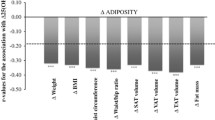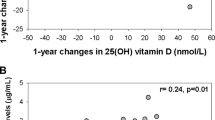Abstract
Objective
We examined associations between body weight and plasma 25-hydroxyvitamin D concentration (25OHD) in prediabetes and sought to estimate the impact of adiposity on these associations.
Methods
The study was conducted in the placebo (n = 1082) and intensive lifestyle (n = 1079) groups of the Diabetes Prevention Program (DPP), a multicenter trial to prevent type 2 diabetes in adults with prediabetes. Weight and 25OHD were measured at baseline, month 6, years 1 and 2. In a subset (n = 584), visceral (VAT) and subcutaneous (SAT) adiposity were assessed by computed tomography at baseline and year 1.
Results
In cross-sectional analyses, baseline body weight, total fat, VAT, and SAT were inversely associated with plasma 25OHD concentration after multivariable adjustment. VAT accounted for 40 % [95 % CI 11, 69] of the association of body weight with plasma 25OHD concentration. There was no significant contribution by total fat or SAT. Two-year changes in plasma 25OHD concentration varied inversely with changes in body weight (p < 0.0001). One-year changes in total fat, VAT, or SAT were not significant mediators of the association between change in plasma 25OHD concentration and body weight.
Conclusion
Our study found an inverse association between body weight and plasma 25OHD concentration at baseline and over a 2-year period in adults with prediabetes. These findings in the DPP, a weight loss intervention study, raise the possibility that weight loss increases plasma 25OHD concentration. Whether adiposity mediates this association remains inconclusive.


Similar content being viewed by others
References
Looker AC et al (2008) Serum 25-hydroxyvitamin D status of the US population: 1988–1994 compared with 2000–2004. Am J Clin Nutr 88(6):1519–1527
Snijder MB et al (2005) Adiposity in relation to vitamin D status and parathyroid hormone levels: a population-based study in older men and women. J Clin Endocrinol Metab 90(7):4119–4123
Bell NH et al (1985) Evidence for alteration of the vitamin D-endocrine system in obese subjects. J Clin Invest 76(1):370–373
Liel Y et al (1988) Low circulating vitamin D in obesity. Calcif Tissue Int 43(4):199–201
Parikh SJ et al (2004) The relationship between obesity and serum 1,25-dihydroxy vitamin D concentrations in healthy adults. J Clin Endocrinol Metab 89(3):1196–1199
Arunabh S et al (2003) Body fat content and 25-hydroxyvitamin D levels in healthy women. J Clin Endocrinol Metab 88(1):157–161
Mason C et al (2011) Effects of weight loss on serum vitamin D in postmenopausal women. Am J Clin Nutr 94(1):95–103
Jorde R et al (2010) Cross-sectional and longitudinal relation between serum 25-hydroxyvitamin D and body mass index: the Tromso study. Eur J Nutr 49(7):401–407
Tzotzas T et al (2010) Rising serum 25-hydroxy-vitamin D levels after weight loss in obese women correlate with improvement in insulin resistance. J Clin Endocrinol Metab 95(9):4251–4257
Newbury L et al (2003) Calcium and vitamin D depletion and elevated parathyroid hormone following biliopancreatic diversion. Obes Surg 13(6):893–895
Rickers H et al (1984) Impairment of vitamin D metabolism and bone mineral content after intestinal bypass for obesity. A longitudinal study. Scand J Gastroenterol 19(2):184–189
Pramyothin P et al (2011) Vitamin D in adipose tissue and serum 25-hydroxyvitamin D after roux-en-Y gastric bypass. Obesity (Silver Spring) 19(11):2228–2234
Reinehr T et al (2007) Vitamin D status and parathyroid hormone in obese children before and after weight loss. Eur J Endocrinol 157(2):225–232
Vimaleswaran KS et al (2013) Causal relationship between obesity and vitamin D status: bi-directional Mendelian randomization analysis of multiple cohorts. PLoS Med 10(2):e1001383
Carlin AM et al (2006) Effect of gastric bypass surgery on vitamin D nutritional status. Surg Obes Relat Dis 2(6):638–642
Wortsman J et al (2000) Decreased bioavailability of vitamin D in obesity. Am J Clin Nutr 72(3):690–693
Alemzadeh R et al (2008) Hypovitaminosis D in obese children and adolescents: relationship with adiposity, insulin sensitivity, ethnicity, and season. Metabolism 57(2):183–191
van der Wielen RP et al (1995) Serum vitamin D concentrations among elderly people in Europe. Lancet 346(8969):207–210
Drincic AT et al (2012) Volumetric dilution, rather than sequestration best explains the low vitamin D status of obesity. Obesity (Silver Spring)
Li J et al (2008) 1alpha,25-Dihydroxyvitamin D hydroxylase in adipocytes. J Steroid Biochem Mol Biol 112(1–3):122–126
Knowler WC et al (2002) Reduction in the incidence of type 2 diabetes with lifestyle intervention or metformin. N Engl J Med 346(6):393–403
Bray GA et al (2008) Relation of central adiposity and body mass index to the development of diabetes in the Diabetes Prevention Program. Am J Clin Nutr 87(5):1212–1218
Lissner D, Mason RS, Posen S (1981) Stability of vitamin D metabolites in human blood serum and plasma. Clin Chem 27(5):773–774
Hankinson SE et al (1989) Effect of transport conditions on the stability of biochemical markers in blood. Clin Chem 35(12):2313–2316
National Institute of Standards and Technology, Standard Reference Materials. 11/3/2010; http://www.nist.gov/srm/
Mayer-Davis EJ et al (2004) Dietary intake in the Diabetes Prevention Program cohort: baseline and 1-year post randomization. Ann Epidemiol 14(10):763–772
Poggio ED et al (2005) Performance of the modification of diet in renal disease and Cockcroft-Gault equations in the estimation of GFR in health and in chronic kidney disease. J Am Soc Nephrol: JASN 16(2):459–466
Diabetes Prevention Program Research G (2012) Long-term safety, tolerability, and weight loss associated with metformin in the diabetes prevention program outcomes study. Diab Care 35(4):731–737
MacKinnon DP, Fairchild AJ, Fritz MS (2007) Mediation analysis. Annu Rev Psychol 58:593–614
Mackinnon DP, Warsi G, Dwyer JH (1995) A simulation study of mediated effect measures. Multivar Behav Res 30(1):41
Baron RM, Kenny DA (1986) The moderator-mediator variable distinction in social psychological research: conceptual, strategic, and statistical considerations. J Personal Soc Psychol 51(6):1173–1182
Harris SS (2006) Vitamin D and African Americans. J Nutr 136(4):1126–1129
Young KA et al (2009) Association of plasma vitamin D levels with adiposity in hispanic and African Americans. J Clin Endocrinol Metab 94(9):3306–3313
Holick MF (2007) Vitamin D deficiency. N Engl J Med 357(3):266–281
Cheng S et al (2010) Adiposity, cardiometabolic risk, and vitamin D status: the Framingham heart study. Diabetes 59(1):242–248
Goodpaster BH et al (2003) Association between regional adipose tissue distribution and both type 2 diabetes and impaired glucose tolerance in elderly men and women. Diabetes Care 26(2):372–379
Hayashi T et al (2003) Visceral adiposity and the risk of impaired glucose tolerance: a prospective study among Japanese Americans. Diabetes Care 26(3):650–655
Kanaya AM et al (2004) Adipocytokines attenuate the association between visceral adiposity and diabetes in older adults. Diabetes Care 27(6):1375–1380
Boyko EJ et al (2000) Visceral adiposity and risk of type 2 diabetes: a prospective study among Japanese Americans. Diabetes Care 23(4):465–471
Thurnham DI (2011) Plasma 25-Hydroxy-Cholecalciferol (Vitamin D) is depressed by inflammation: implications and parallels with other micronutrients. Sight Life 25(2):38–47
Duncan A et al (2012) Quantitative data on the magnitude of the systemic inflammatory response and its effect on micronutrient status based on plasma measurements. Am J Clin Nutr 95(1):64–71
Acknowledgments
We acknowledge the commitment and dedication of the DPP participants.
Author contributions
L.C, J.W, K.D.A, G.A.B, A.G.P were responsible for the study design. CG conducted the 25OHD assay analysis. J.N was responsible for the statistical analysis. All authors were involved in the interpretation of the data. All authors and the DPP Publications and Ancillary Studies Committees were involved in the critical revision of the manuscript for intellectual content.
Author information
Authors and Affiliations
Consortia
Corresponding author
Ethics declarations
Conflict of interest
None disclosed.
Funding
The present ancillary study was supported by research Grant R01DK79003 (to AGP) from the National Institute of Diabetes and Digestive and Kidney Disease; UL1RR025752 (to Tufts University) from the National Center for Research Resources and the National Center for Advancing Translational Sciences, National Institutes of Health; a research grant by the Gerald J. and Dorothy R. Friedman Foundation (to LC); the US Department of Agriculture Agreement 58-1950-9001 (to BDH). The parent DPP study was supported by research Grant UO1DK48489 from the National Institute of Diabetes and Digestive and Kidney Diseases (NIDDK) of the National Institutes of Health to the DPP clinical centers and the Coordinating Center for the design and conduct of the DPP study. The Southwestern American Indian Centers were supported directly by the NIDDK, including its Intramural Research Program, and the Indian Health Service. The General Clinical Research Center Program, National Center for Research Resources, supported data collection at many of the clinical centers. Funding was also provided by the National Institute of Child Health and Human Development, the National Institute on Aging, the National Eye Institute, the National Heart Lung and Blood Institute, the Office of Research on Women’s Health, the National Center for Minority Health and Human Disease, the Centers for Disease Control and Prevention, the Indian Health Service, and the American Diabetes Association. Lipha (Merck-Sante) provided medication. LifeScan Inc., Merck-Medco Managed Care, Inc., and Merck and Co. donated materials, equipment, or medicines for concomitant conditions.
Additional information
Disclaimer
The authors of this report are responsible for its content. Statements in the report should not be construed as endorsement by the National Institutes of Health, the US Department of Health and Human Services.
The content is solely the responsibility of the authors and does not necessarily represent the official views of the NIH, the US Department of Health and Human Services or the above-listed institutions.
Electronic supplementary material
Below is the link to the electronic supplementary material.
Rights and permissions
About this article
Cite this article
Ceglia, L., Nelson, J., Ware, J. et al. Association between body weight and composition and plasma 25-hydroxyvitamin D level in the Diabetes Prevention Program. Eur J Nutr 56, 161–170 (2017). https://doi.org/10.1007/s00394-015-1066-z
Received:
Accepted:
Published:
Issue Date:
DOI: https://doi.org/10.1007/s00394-015-1066-z




